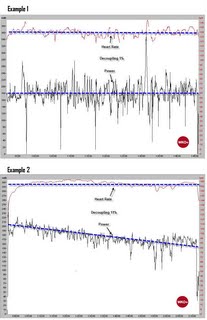The Aerobic Base Ride - More
Labels: aerobic, anaerobic endurance, heart rate, zone 2
Joe Friel's Blog is for the serious endurance athlete who wants to stay current on the science and art of training for sport. Here you will find Joe Friel's thoughts and ideas before they are published anywhere else. You may also visit www.TrainingBible.com for more detailed and free content.
Labels: aerobic, anaerobic endurance, heart rate, zone 2
A few weeks ago I suggested to Markus Zimmer, the owner of the Bicycle Ranch bike shop in Scottsdale, Ariz. where I shop that the store’s Saturday ride should include a “base” group in addition to it’s A-, B- and C-ability grouped rides. I usually ride with the Bs and occasionally with the As. This is only in the spring and fall. During the summer I am in Boulder, Colo. I’m also in Scottsdale during the winter but almost never ride with the group then because the A and B rides are basically mini-races. That’s great when I’m preparing to race. In the winter, however, my training purpose is not race fitness; it’s base fitness. You don’t establish base fitness by going deeply anaerobic repeatedly for a couple of hours.
Markus liked the idea and so last Saturday he offered a base group in addition to the three normal groups. There were probably 60 riders who showed up. Nearly all of them rode with the base group led by local coach Ron Arroyo. (I was injured and couldn’t ride. Fell on my knee a couple of weeks ago. That’s a whole other story I may get to at another time.)
My notion of a base ride is a long, steady workout with heart rate mostly in zone 2. This is roughly a well-conditioned athlete’s aerobic threshold. Riding two or more hours at this effort challenges the body to make some improvements. One is to become better at using fat for fuel while sparing muscle glycogen stores. The longer your races are, the more important this shift is. The other critical shift has to do with increasing the capillary bed in the working muscles. The more capillaries you have the easier it is to get fuel and oxygen to the muscle. There are other benefits also, but for now we’ll focus on these.
The problem with this base workout is that it seems too easy at first so the athlete is tempted to abandon the 2 zone and start riding variably paced with hard and easy efforts – fartlek intervals, essentially. And by so doing reduces the aerobic benefits of the day’s workout.
The aerobic threshold ride is sort of like Chinese water torture. What at first seems easily manageable eventually becomes challenging. One has to have the patience to hang in there to see what I mean. (This is one of the numerous reasons why I so often say that patience is necessary to be a good endurance athlete.) Ride for two, three, four hours at this effort and you soon learn what the aerobic system is all about.
Doing such a workout with a group presents problems, however. The greatest is that not everyone’s heart rate 2 zone produces the same power or speed. The highly fit, usually young riders are talking easily while riding in zone 2 – as they should be. The slower, usually older riders who try to keep up are often well out of zone 2 but determined to hang on. While this workout is best done alone, if in a group the best option is for the group to split up into smaller groups of like ability.
The best way to do this ride is to have a power meter onboard in addition to your heart rate monitor. While in the base period I like to have athletes use their heart rate monitors to set the effort, what happens to power is the real story. The best way to explain this is to use graphics.
Here you see two examples (click graphic to expand) of riders doing a steady, multi-hour, zone-2 ride. In both cases they are doing an excellent job of maintaining a steady heart rate as evidenced by the red line staying almost flat on both charts. But notice what happens to power (black line). In example 1 power closely parallels heart rate. That’s good. It says that the rider is staying “strong” throughout the ride. There is no fading of power (or slowing down, if you will, even though that’s not a very precise way to measure output on a bike). I call this separation of heart rate and power ‘decoupling.’ In fact, WKO+ software shows us that in example 1 there was only 1% of decoupling. In other words, power declined only 1% over the course of two hours of riding.
For the rider in example 2, however, the decoupling is 11%. He is fading significantly as the ride progresses. From these two examples I can tell you unequivocally that rider #1 is in much better aerobic condition than rider #2. If all they had were heart rate monitors we wouldn’t know this. Heart rate is only effective when we can compare it with something else. By itself it tells us nothing about aerobic fitness.
So does this mean that if you don’t have a power meter you shouldn’t do this workout? No, not at all. It’s still beneficial to your aerobic system. You just can’t measure your progress or know for certain when you’ve achieved good aerobic fitness. About all you can do in this case is to pay close attention to how you feel. If in good aerobic condition you should be able to finish the ride strongly, albeit tired. If you’re totally whipped after two hours and are struggling just to limp home although heart rate remains in the 2 zone, your aerobic fitness probably needs a lot of work.
Labels: aerobic, AeT, base, decoupling, endurance, wko+, zone 2